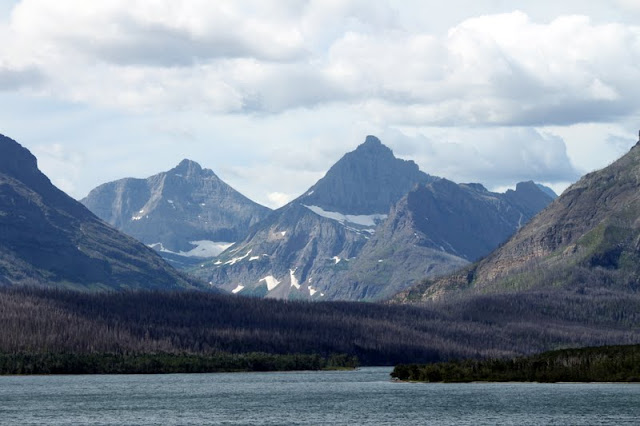WEDNESDAY AUGUST 03, 2011: Nancy and I had breakfast at the local cafe before we departed the St. Mary's, MT campground at 8:20 a.m. It was a cool 54 degrees and sunny when we stopped for fuel in Shelby where we purchased our cheapest diesel so far on the trip at 3.829/gal. By the time we reached Helena it had started to drizzle rain; soon the sky got dark and we experienced several rain storms and once it even hailed. By 4:30 p.m. we were all ready to stop for the day so we're spending the night at the Bozeman, MT WalMart.
 |
| YOU NEVER KNOW WHAT YOU'LL SEE ON THE HIGHWAY |
 |
| BLACKFEET INDIAN RESERVATION MONUMENT (I ALWAYS HEARD "BLACKFOOT" BUT "BLACKFEET" IS CORRECT, THEY WERE SO NAMED BECAUSE THEIR MOCCASINS WERE BLACKENED BY CAMPFIRES) |
THURSDAY AUGUST 04, 2011: When we left Bozeman, MT it was a sunny 60 degrees. When we arrived at the Little Bighorn National Park at about 11:30 a.m. we were surprised when we found the few RV parking spots full. By that time we had no choice but to continue through the entire five mile tour loop with motor homes and tow vehicles still attached. After we made the loop and exited the park we parked the motor homes at a nearby casino and returned to the park via the jeeps.
We enjoyed a very informative "Ranger Talk" about the history prior to and during the battle infamously called "Custer's Last Stand." I found that much of what I'd been taught about the battle was false and that Custer was unfairly blamed for the defeat. The Indian Tribes had agreed to treaties which gave them a reservation with lands including the Black Hills which were sacred to them. When gold was discovered in the Black Hills the government redrew reservation boundaries to exclude the area so the "white man" could access the gold. Further, they had been promised food which didn't materialize and they were forced to leave the reservation to hunt for food. The Army was ordered to return the Indians to the reservation, and if they wouldn't return, they were to be considered hostiles and eliminated. Custer's 7th Calvary was only one of three units committed to the battle and Custer had no way of knowing that the other two units had met heavy resistance and weren't in place to support his position. He and his men were all alone and were vastly outnumbered by angry Indians who had been betrayed by the US Government. Custer and his men had little cover and we even forced to kill their horses so they could take position behind their bodies. Once the men of the 7th ran out of ammunition they were over run and killed.
By the time we returned to the motor homes it was 97 degrees, so we decided to overnight at a campground about 100 miles away in Buffalo, Wyoming. The campground is very nice and we're running both air conditioners and hope to enjoy a restful night before we hit-the-road again at 8 in the morning.
 |
| IF YOU LOOK CLOSE YOU CAN SEE WHITE MARKERS ON THE BATTLEFIELD. THESE MARKERS HAVE THE NAME OF SOLDERS KILLED ON THAT SPOT. THIS IS THE ONLY PLACE IN THE US AND ONE OF ONLY THREE IN THE WORLD WHICH MARKS THE PLACES WHERE INDIVIDUAL SOLDERS DIED. IN 2009 "RED" MARKERS WITH THE INDIAN'S NAMES WERE PLACED TO MARK WHERE THEY DIED. |
 |
THE DAY AFTER THE BATTLE THE INDIANS HAD WITHDRAWN AND THE OTHER ARMY UNITS HASTILY BURIED THE DEAD IN SHALLOW GRAVES. YEARS LATER THE BODIES OF THE OFFICERS WERE RETURNED TO THEIR FAMILIES. THE BODIES OF THE ENLISTED SOLDERS, 47% OF WHOM WERE IMMIGRANTS, WERE REBURIED IN A MASS GRAVE MARKED BY THIS MONUMENT.
|














































